Aug 23 2013
Over the last few years, the use of nanomaterials for water treatment, food packaging, pesticides, cosmetics and other industries has increased. For example, farmers have used silver nanoparticles as a pesticide because of their capability to suppress the growth of harmful organisms.
 As part of MU Associate Professor Mengshi Lin's study about how toxic nanoparticles may enter our food supply, graduate student Zhong Zhang applies silver nanoparticles to an apple. Mengshi's food science study has found that these particles could pose a potential health risk to humans and the environment. Thanks to their study, a reliable method of testing foods for the harmful particles has been found that might be implimented in the future. Images by Kyle Spradley | © MU College of Agriculture, Food & Natural Resoruces
As part of MU Associate Professor Mengshi Lin's study about how toxic nanoparticles may enter our food supply, graduate student Zhong Zhang applies silver nanoparticles to an apple. Mengshi's food science study has found that these particles could pose a potential health risk to humans and the environment. Thanks to their study, a reliable method of testing foods for the harmful particles has been found that might be implimented in the future. Images by Kyle Spradley | © MU College of Agriculture, Food & Natural Resoruces
However, a growing concern is that these particles could pose a potential health risk to humans and the environment. In a new study, researchers at the University of Missouri have developed a reliable method for detecting silver nanoparticles in fresh produce and other food products.
“More than 1,000 products on the market are nanotechnology-based products,” said Mengshi Lin, associate professor of food science in the MU College of Agriculture, Food and Natural Resources. “This is a concern because we do not know the toxicity of the nanoparticles. Our goal is to detect, identify and quantify these nanoparticles in food and food products and study their toxicity as soon as possible.”
Lin and his colleagues, including MU scientists Azlin Mustapha and Bongkosh Vardhanabhuti, studied the residue and penetration of silver nanoparticles on pear skin. First, the scientists immersed the pears in a silver nanoparticle solution similar to pesticide application. The pears were then washed and rinsed repeatedly. Results showed that four days after the treatment and rinsing, silver nanoparticles were still attached to the skin, and the smaller particles were able to penetrate the skin and reach the pear pulp.
“The penetration of silver nanoparticles is dangerous to consumers because they have the ability to relocate in the human body after digestion,” Lin said. “Therefore, smaller nanoparticles may be more harmful to consumers than larger counterparts.”
When ingested, nanoparticles pass into the blood and lymph system, circulate through the body and reach potentially sensitive sites such as the spleen, brain, liver and heart.
The growing trend to use other types of nanoparticles has revolutionized the food industry by enhancing flavors, improving supplement delivery, keeping food fresh longer and brightening the colors of food. However, researchers worry that the use of silver nanoparticles could harm the human body.
“This study provides a promising approach for detecting the contamination of silver nanoparticles in food crops or other agricultural products,” Lin said.
Members of Lin’s research team also included Zhong Zang, a food science graduate student. The study was published in the Journal of Agricultural and Food Chemistry.